How we head off for adventure with a simple but effective setup in our 2012 T31 Nissan X-Trail
Don't wanna be here? Send us removal request.
Text
Cask strength our favourite. Distillery in our satnav!
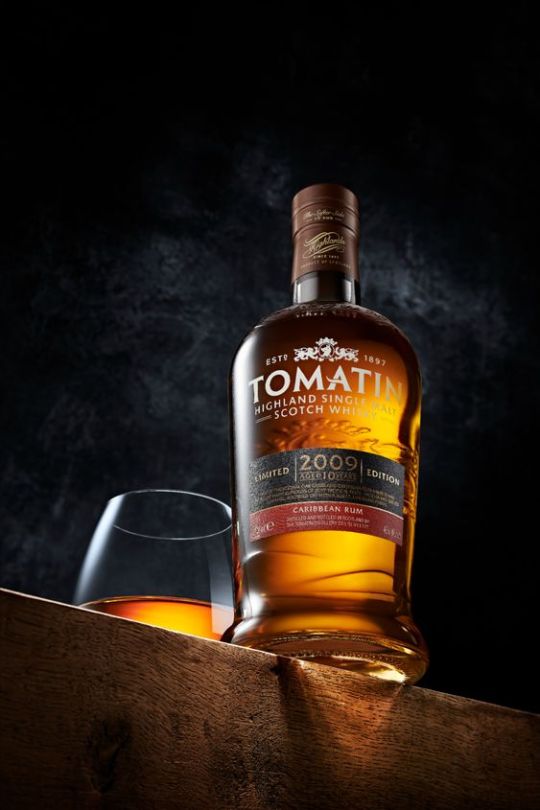
27 notes
·
View notes
Text
Car Camping Cook Box becomes Beach BBQ Box

The Beach BBQ Box
Having everything ready to go makes eating outdoors far easier, particularly given the UK's unpredictable weather. We started using a tool box containing our camping cooking gear to permanently keep in the car a couple of years ago (see above) & the arrival of version two of that made the original available for the beach. After a few uses some modifications were needed.
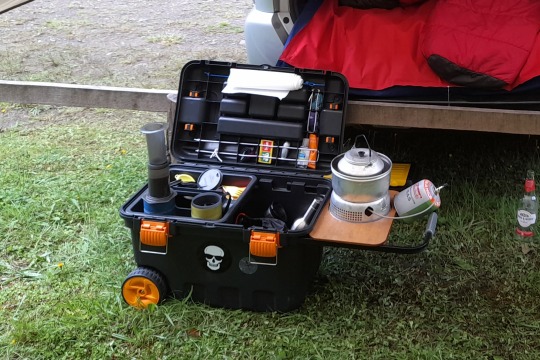
Cook Box Version A in use in Scotland.
The contents are slightly tailored to make setting up, cooking & clearing up after a beach BBQ much easier. (If only all the people who use our beach while on holiday got the second part right - or at all.)
It's constantly evolving & we often add a few things from the car box, but the pictures below give you the idea.
Clearly it then needed to be made more Star Wars, because everything is better with Star Wars.
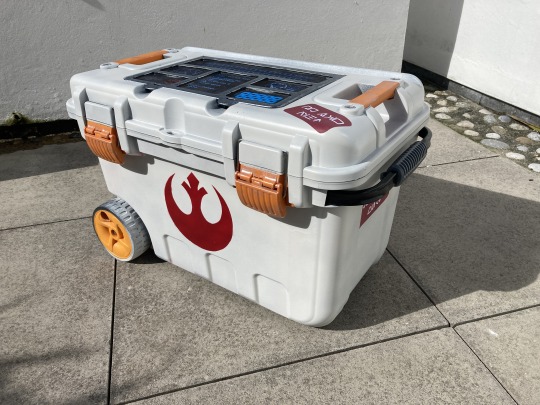
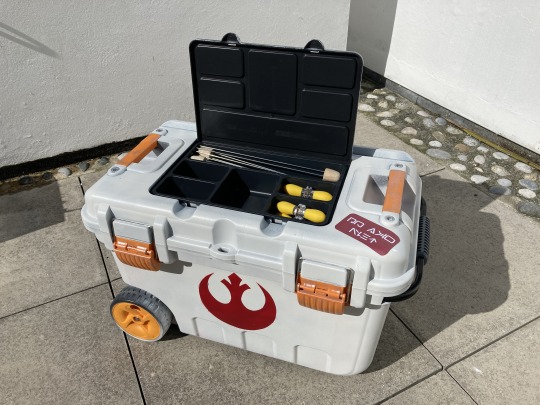

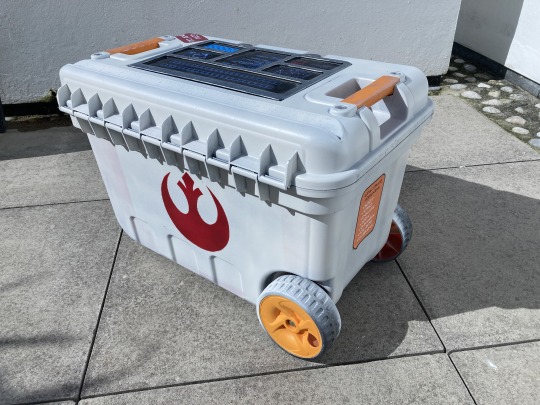
Beach Box in Rebel Alliance colours showing some of the contents
Once painted it then needed to be distressed:
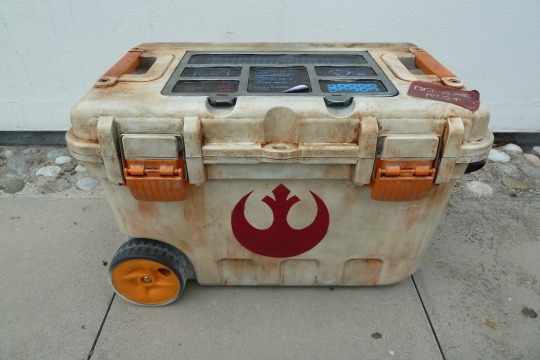
Beach Box in distressed Rebel Alliance colours
The eagle eyed will notice that in the transition to beach box some holes have appeared in the wheels. This is because across sand (even a few yards - we live right on the beach) it's off-road ability was lacking, plus coming home after dark across cobbles was really noisy.
I had some trolley wheels spare (not the lightest but we work with what we have where possible) and some FloPlast solvent weld pipe & clips kicking around & this was the best way to add wheels without compromising the integrity of the box & making them removable.
Here it is in off-road setup:
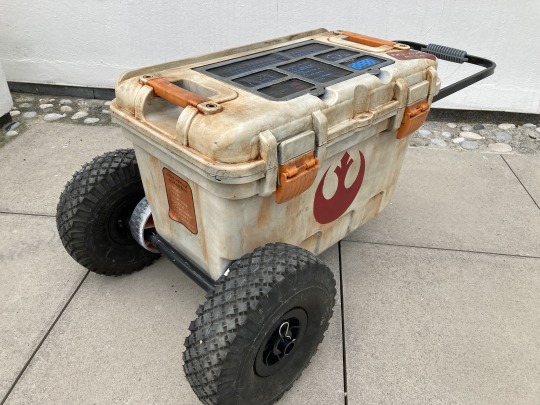
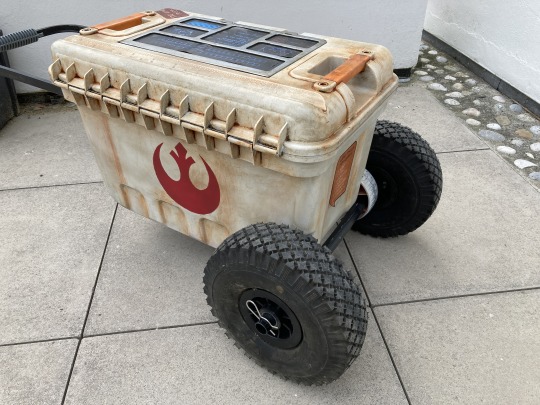
Beach Box in off-road setup.
The box means we can BBQ easily whilst keeping our gear contained, sand free & food off the deck.
1 note
·
View note
Text
Car Camping Setup
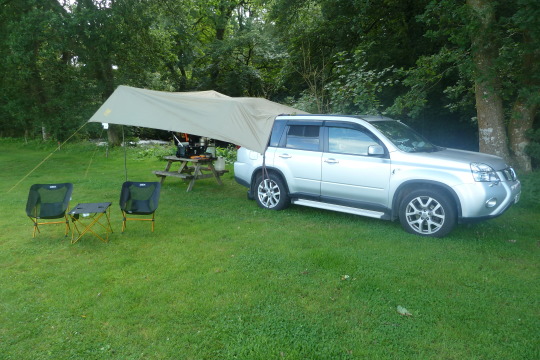
Deluxe tarp setup on a Dartmoor campsite with commandeered picnic table.
We live in a small home & funds are tight, so we have restricted ourselves hugely in what we buy:
If it lives in our small apartment, it needs to have at least two uses, if not three.
If it’s used in the car it needs to be compact, flexible & removable.
If we can avoid spending money we will & Wombling has become a permanent occupation. We live in a wealthy tourist destination & the devastating environmental impact of this is worsened by the relentless drive to refurbish & renew. A careful watch on neighbouring building work & even our own bin-store often reveal a treasure trove of useful materials. The 90% of the apartments in our block which are second homes provide rich pickings - most of the absentee landlords are far too busy to recycle & the letting agencies are constantly insisting on replacement furniture.
For short overnight trips into the wild, this is how we roll.
Tarp Setup

Basic tarp setup on a Dartmoor campsite.
Our tarp of choice is the Slumberjack Roadhouse Tarp. Sure we could get a blue tarp from a builders’ merchants & some generic poles & cord, but the extra we’ve spent on this is well justified. We find it is:
Well thought out. It has straps where you need them to secure to the wheels & roof bars or similar.
Comes with decent pegs & reflective guy lines to set up over the rear door as we use it of free-standing.
Well constructed with robust tabs & eyelets.
Lightweight & packs up small - in fact slides into the LHS boot underfloor storage easily.
Provided with sturdy steel poles. (Maybe these could be lighter, but they are certainly strong enough.)
The Slumber Shack 4-Person Tent would be a decent progression & add some flexibility, but we’re happy with this for our purposes & we have a hike tent or more palatial 4/6-berth gin palace if we need.
The tarp is only really an extension of the real door which because it opens upwards provides some protection from horizontal rain while making use of the flat rear floor for cooking.
Sleeping Setup
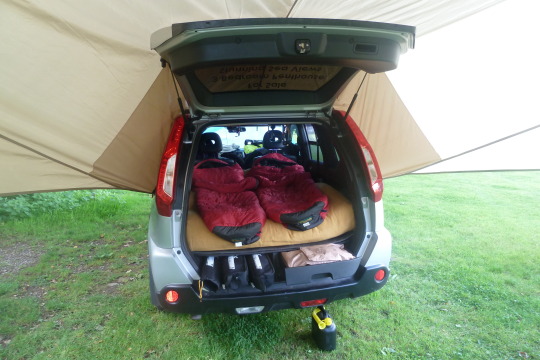
Sleeping setup on a Dartmoor campsite.
That the X-Trail seats fold flat is not only brilliant for load carrying but it also makes it a great camping platform.
We tried an air bed on our first outing in Scotland but the addition of the right mattress has made for a deluxe night’s sleep without the bouncing. We’ve gone with a Futon Company Authentic Futon - For Double Sofa Beds.
In good weather we can keep the rear door open & the futon & our feet can hang out of the back. If the weather deteriorates we can either pull it inside slightly or even close the door. The latter option restricts lying flat out but is bearable in extremis.
At home (because of the optimising gear thing) by day it is the sofa seat & back for the sofa-bed in our office/guest room, or the headboard if we have a guest. It could also be a further double bed in the lounge if we one double bed isn’t enough for guests. Three jobs in one!
In the under-floor space on the left we keep the tarp unless it’s in use plus a mallet & our lightweight folding table & chairs. In the drawer space on the right we have had a reorganisation recently & the current intention is that’s the food/camping sundries store. That may change.
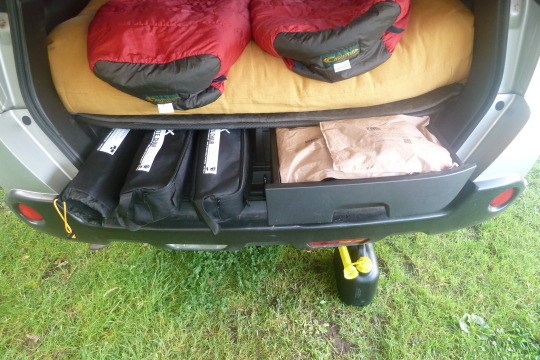
Camping furniture & rations showing in the under-floor storage.
Tips & Tricks
It’s often the little things that can make or break a camping trip. Here are two.
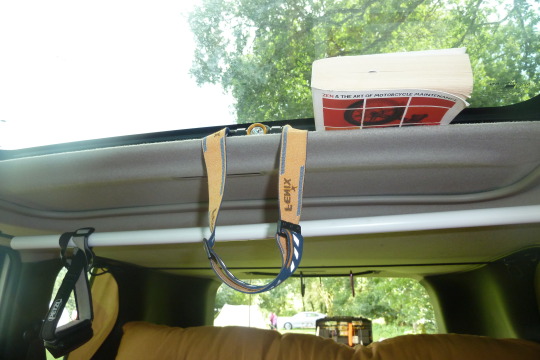
Handy shelf.
Storage: Having started by hanging gear from the ceiling handles, straps & bungees, inspiration struck whilst lying awake one morning gazing out of the sunroof in that the sunroof cover makes a handy adjustable shelf. Just remember what you put there & remove it before you set off.
Midges: An open window on a vehicle with humans inside exhaling carbon dioxide is an invitation to the voracious Scottish midge. They will find the smallest ventilation crack & love to feast on human flesh. They never sleep. The answer is a bug-screen.
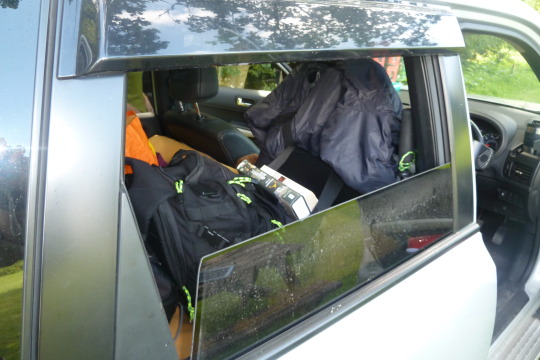
Open window/invitation for midges.
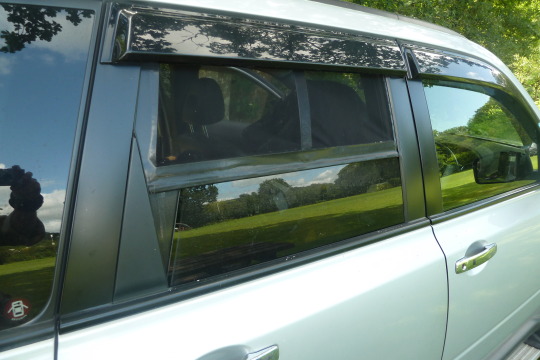
Bug-screens Version One fitted - external view.
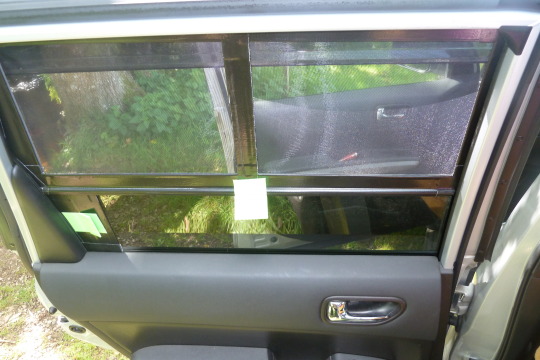
Bug-screens Version One fitted - internal view.
They are straightforward to tailor make for your vehicle - just order the raw material from any number of eBay suppliers. (I can’t remember which one I used.)
I made a carboard template first & then knocked a pair together from a relatively small amount of the fabric, some plastic sheeting & electrical conduit I had from another job & Gorilla Tape. Here’s how they look:

Bug-screens Version One - Lay flat.
There is plenty left over from the 2m we got to make a roller blind affair for the rear door, but for now we’ve not needed it.
Since making these I’ve found a design for a more robust & discrete version here, but I’m in no rush to upgrade just yet.
Cooking Setup
I’ve made two other posts about the cook box and its contents, so go check them out, but here are the two ways it can be deployed out of the vehicle:
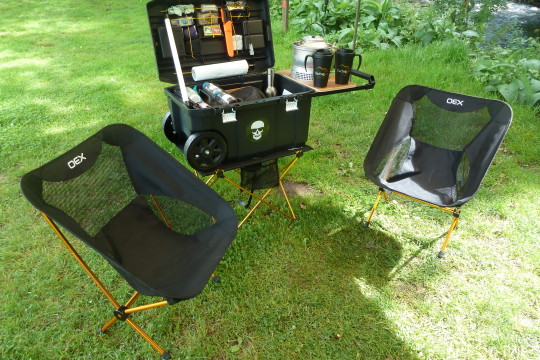
Basic wilderness setup.
The OEX table & chairs were a trial purchase - they seem to be a house brand for Blacks/Millets/GoOutdoors & were pretty cheap. One day an upgrade to Helinox or similar may happen but for a fifth of the price of lighter alternatives they have been excellent.
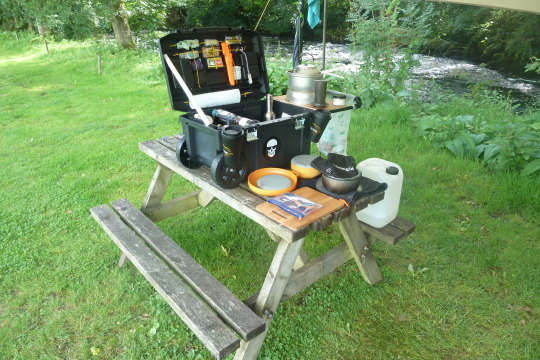
Deluxe campsite setup.
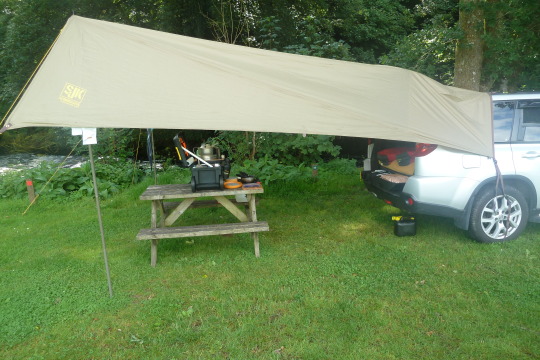
The kettle on for an early morning cup of tea.
Over two very windy rainy nights on a Dartmoor campsite we were very comfortable & slept well. (Thinking about pitching helps, but I’m not attempting to teach basic skills that should have learnt in the cubs & scouts.)
You may find this setup a little exposed on a busy campsite but this was only a training run & where we go in Scotland nobody will be looking through the windows.
Everything stows neatly in the boot & we can cater en route happily with this setup.
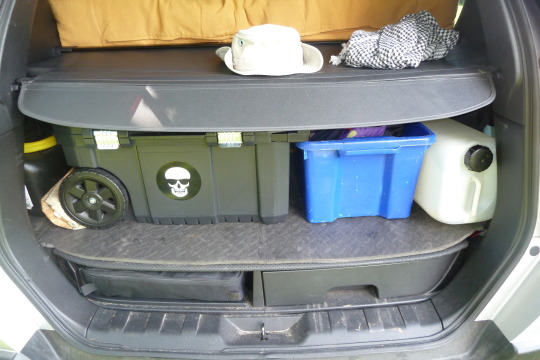
Gear stowed in transit.
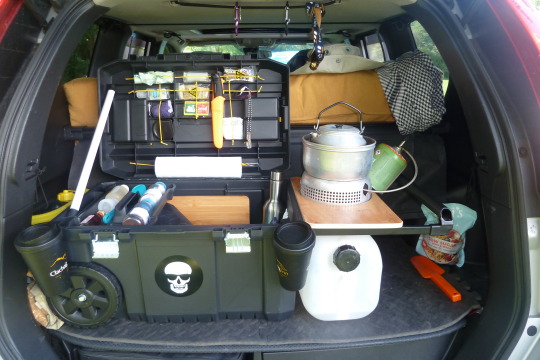
Brew or meal prep is easy en route.
For a quick brew we leave the can of spare diesel in the vehicle, but:
It’s on the far side from the Trangia.
We don’t use Methylated spirits in this configuration - only gas.
On a stop we put it outside.
That's how we roll, but if you have a better way then by all means share.
1 note
·
View note
Text
The Cook Box Contents
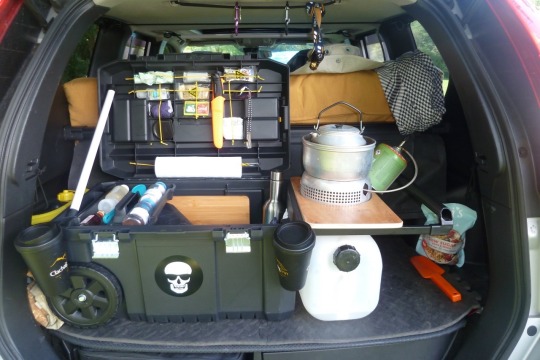
The back of The Millennium Falcon in brewing up mode.
Our gear is constantly evolving & also depends on what we’re up to. Here is what we are currently using & why, listed below the relevant picture from a recent trip car camping & walking on Dartmoor. (Links & comments if I have them.)
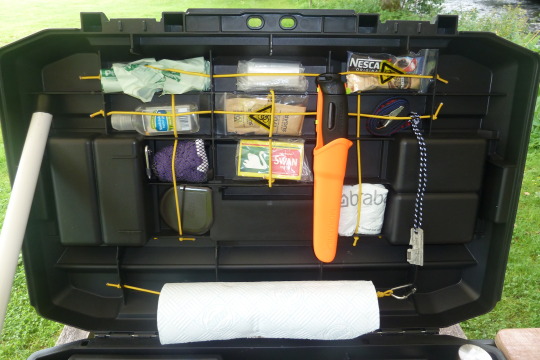
From top left to right, fixed in with readily available shock cord or zip ties:
Recyclable rubbish bags. Leave no trace & take it home.
Small grip seal bags. Lots of uses.
Coffee sachets in a small grip seal bag.
Hand sanitiser. Useful if water is short - wash your hands when preparing food & avoid getting ill.
Mora Companion Spark. Actually in the sheath from a Companion SRT (S) as I wanted it to stand out. A sharp knife rattling around in a cook box is inviting injury, especially in the dark, so it seemed sensible to use one of these. Stainless steel for easy/sloppy care. The "Spark" refers to the ferro rod in the handle which is an alternative means of lighting the Trangia.
The strap from the Trangia.
One of two microfibre towels used as teatowels.
Matches in a small grip seal bag.
Pan scraper. Never used it as I strive not to get pans dirty in the first place.
Brabantia swing bin liner - no idea why.
Army issue tin opener. Simple, light & effective.
Kitchen roll.
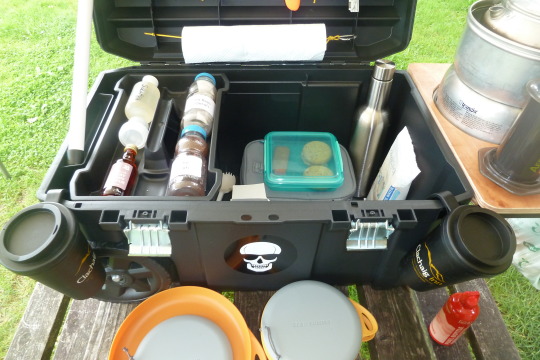
From left to right, fixed in with readily available shock cord or zip ties:
Bottlegreen Elderflower Cordial (quite concentrated so lasts) in a bottle from the versatile & ubiquitous Nalgene Leakproof Container Travel Kit - Medium.
Various brew kit items - coffee, tea bags, sometimes creamer or hot chocolate etc. which we keep in small Tropicana orange juice bottles from McDonalds or supermarket meal deals.
Random spork from a British Army ration pack. (What we were eating on this trip.)
Unbranded cool bag. Just enough for bacon & eggs, butter, ketchup & some bread rolls for breakfast when the rations ran out.
Sistema box. Really useful in various forms to keep food.
Insulated wine bottle. Actually contains milk on this trip & is a really annoying size but it’s what we have so we use it. If we go to the beach it will contain Gallo Family Vineyards White Grenache 75cl.
Wet wipes. Hard to find ones that don’t smell of babies but since I worked with a Royal Marine who swore by them I’ve used them too.
Thermal mugs from The Clachaig Inn, Scotland. A most excellent hostelry frequented by gnarly mountain climbing types. Marks their owners out as proper outdoors people.
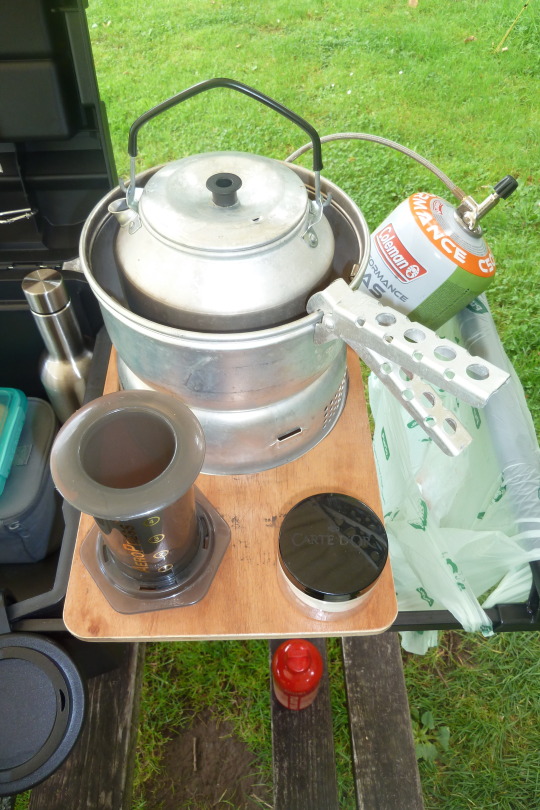
Brewing up gear includes:
Trangia 25 with the Trangia Gas burner GB74 for speed & adjustability (or the spirit burner for peaceful early mornings). This is non-stick but beyond that I couldn’t identify it from the bewildering array of materials & weights on the Trangia website. I’ve used them for 40 years & this one is about 25 years old. Bomb proof - get one.
AeroPress coffee maker. Because it’s important to have good coffee wherever you are.
Carte D’Or tub for storing AeroPress filters which comes with a fee serving of ice-cream. This came from Sainsburys but now seemingly unavailable.
Coleman C500 Performance Gas Cartridge. Any 80% Butane / 20% Propane gas canister will be fine at low altitude - these are freely available & last us a while. Coleman are mysterious about their ratios & as not all their canisters are marked I had to ask. They say: “We can confirm the following difference between Performance and Xtreme gas cartridges: • Performance: 80% Butane / 20% Propane • Xtreme: 70% Butane / 30% Propane The higher % of Propane of the Xtreme make it tthat you can use it in colder temperatures”.
Sigg Fuel Bottle. Sigg don’t seem to have fuel bottles on their website any more but they were always good & reliable. The holes in the thread mean you don’t need to take off (& lose) the lid to pour. The loop in the lid means you can apply plenty of leverage is the lid gets stuck.
The rubbish bags hang neatly over the end of the handle so ditching used teabags etc. is simple.
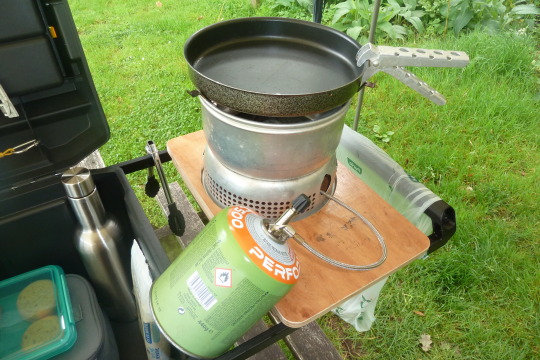
Cooking makes use of the Trangia 25 again but if frying (bacon & eggs on this occasion) moving the Trangia work surface away from the open box minimises the effects of spitting oil & fat.
The bars of the handle make a convenient place to hang the tongs.
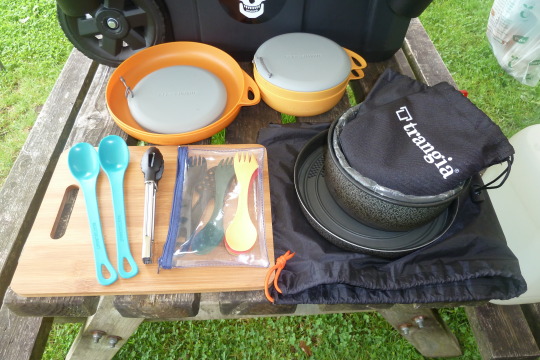
Sea To Summit’s Delta Range are excellent & our Goldilocks plates because they:
Stack well enough.
Have high sides so your food doesn’t slide off.
Curve perfectly so your Spork can remove maximum food.
Have a thumb grip which also serves as a hanging loop. (Or a cord on the bowl lids.)
The bowls have a lid to seal in food.
I searched for a long time before deciding on these & they have proved outstanding.
Top left to right:
Delta plate
Delta bowl Lid
Two Delta plates
Two Delta bowls with a lid
Long handled Delta spoon - as we were eating Meals Ready to Eat (MREs) as issued to British troops.
Generic tongs (these from TK Maxx but ubiquitous)
Pencil case containing:
Several Light My Fire Original Sporks - still the best IMHO
TREKMATES Snaxtool 6in1 Camping Utensil - so convenient I had to buy them, though possibly just the Sporks would be fine.
Bamboo chopping board. This one was from Morrisons but they are everywhere - get one the size that suits your box.
Trangia accessories:
Pan Stand
Triangle
A bag I made myself.
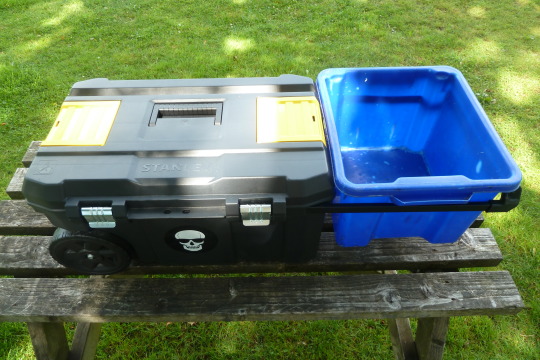
We've had several of these blue stacking boxes at home for years. This happy little accident makes moving gear away from the car easier.
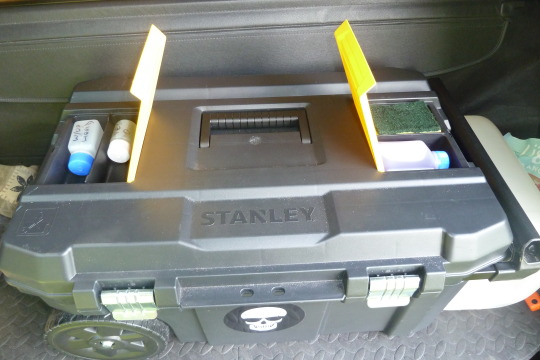
The hatches in the lid store, in bottles from the Nalgene set above, from top left to right:
Washing up liquid (AKA Dishsoap).
Cooking oil.
Pan sponge/scourer.
Methylated spirits (for the Trangia if we don't pack the larger fuel bottle).
Always looking for possible improvements - next is a better way to hang the mugs which avoids spillage whilst brewing up.
Share & enjoy.
1 note
·
View note
Text
The Cook Box
One of the requirements for The Millennium Falcon was to camp from or in it & to do so we needed to be able to cook.
My chosen stove for vehicle based camping has been the trusty Trangia, which when combined with a gas burner (Gas burner GB74) becomes an extremely flexible way to cook for two.
What we needed, however, was a means of storing the stove & associated paraphernalia so we could brew or cook at a moments notice, simply by adding food &/or water. We also needed a surface for the Trangia.
It was whilst wandering aimlessly through the DIY section of our local B&M one day that I came across a rolling tool box (their own brand as I recall), inspiration struck & The Millennium Falcon’s Cook Box was born. Here it is in its first iteration, in use in Scotland on our first night sleeping out in the wild:

Cook Box Version A in use in Scotland.
The killer app was in creating a stable work surface on which to use the Trangia, whilst keeping access to the box & its contents.
A rummage through my plywood offcuts stash & a little work with a Stanley knife, jig saw, wood glue & varnish and the “Trangia Work Surface” was born:

The Trangia Work Surfaces from the two box versions to show the top & bottom surfaces & so the simple construction.
If you want to replicate this, the measurements will depend on your chosen rolling toolbox base, but the methodology will be the same:
The length of the top surface (the bit with the Trangia base sized hole) needs to be enough to sit on the extended arms of the towing handle. It needs to be short enough to fit inside your box.
The length of the bottom surface needs to sit snugly inside the extended arms of the towing handle.
The width of both pieces needs to be narrow enough to fit inside your box, allowing for any tool tray that you retain.
“Cook Box Version A” has since been relegated to “Beach Box Version A”, but the photos below show how it works, albeit in its new Rebel Alliance livery. (Because everything is better with Star Wars.)
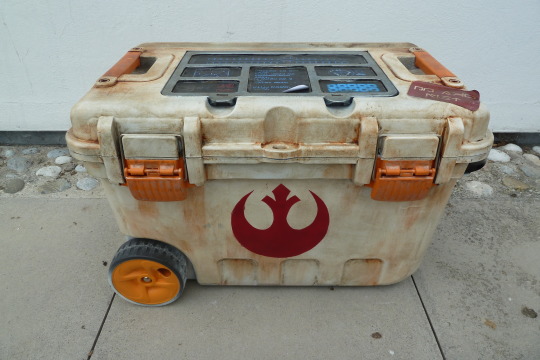
“Cook Box Version A” in Star Wars Livery, so “Beach Box Version A”. (The holes in its wheels are for the axle of its all-terrain wheels.)

Beach Box Version A with its Trangia work surface stowed.

Beach Box Version A with its Trangia (now picnic plate) work surface deployed.
Version A worked very well in many ways for some time - the only exception being its height. The Millennium Falcon has a sprung bar across the rear load area which supports the cover that shields the contents from prying eyes. Version A didn’t slide under this, so couldn’t be stored out of the way towards the back of the rear seats, & quickly became annoying. (This problem is likely unique to the Nissan X-Trail & you may find any size box will work with your vehicle, but its worth taking some measurements & bearing this in mind before flexing your credit card.) It wasn’t for a couple of years fruitlessly wandering more DIY sections that Homebase finally yielded the Stanley Tool Chest 26". (At time of writing weirdly absent from the Stanley UK website, but still available for £36.00 from the Homebase website here.)

Cook Box Version B

Cook Box Version B with its Trangia work surface stowed.

Cook Box Version B with its Trangia work surface deployed.
Version B had its first test in the wild on Dartmoor recently, where it worked perfectly:
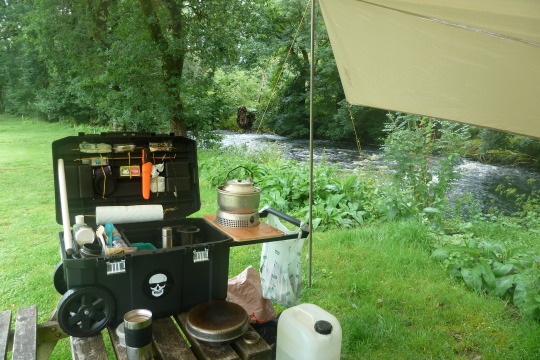
Cook Box Version B in use on Dartmoor.

Cook Box Version B in use in the back of The Millennium Falcon on Dartmoor.

Cook Box Version B stowed in day to day transit.
If you choose to replicate this means of storing & using you cooking gear then what you choose to accommodate will depend on your preferences. I’ve made it to fit my Trangia, and the space available in our vehicle, but it would work equally well for many other stoves. (Be sure it doesn’t transmit heat down or you may burn more than your dinner!)
I’ll list the contents we’ve found work for us in a separate post in due course. Our gear is constantly evolving & also depends on what we’re up to. It is beautifully flexible in that we can use it in the back of The Millennium Falcon, on our own lightweight table, a wooden picnic table/bench (as above) or even the ground.
One word of caution however is that if we use it car-based:
We use the gas burner, not the spirit burner. (Liquid fuel spilling inside the car will not end well.)
We are careful not to have the flame burning with nothing between it & the car roof. Once lit, the pot or kettle goes on immediately & we switch off before removing them.
If you borrow this idea, or adapt it in any way, we’d be interested to see pictures as we’ve never seen anything similar.
Happy camping!
#nissan#x-trail#car camping#chuck box#cooking#camping#trangia#star wars#rebel alliance#kitchen#kitchen box
2 notes
·
View notes
Text
The Millennium Falcon
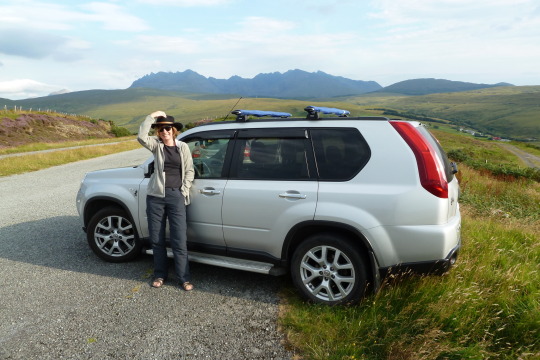
Princess Leia with The Millennium Falcon on The Isle of Skye in August 2020.
How It All Began
In 2018 we bought a well maintained low mileage Nissan X-Trail T31 with several aims in mind:
Be a daily driver, though we live in town, walk most places & have little need to drive far or often.
Take us, plus the piles of equipment we use, up to Scotland, hopefully every year, to climb Munros, canoe lochs, camp both via water & walks & generally enjoy the outdoors north of the border. We didn’t want to be beaten by rough terrain.
Be a platform for camping - from or in depending on circumstances.
Move our possessions around the country when needed.
Be a reliable mode of transport for all the above. Having been sold on Japanese reliability by countless AA patrolmen over many decades, plus our own experience with a Honda Civic which was a stopgap for a year that turned into nine, Nissan was an obvious option.
The limitations on the vehicle we chose were that it needed to fit our narrow allocated parking space in the garage beneath our 70′s apartment block but maximise load space both inside & on the roof. (Headroom 1.9m!)
The car we bought has fitted the bill perfectly. We named it The Millennium Falcon, because everything’s better with Star Wars.
As I understand the X-Trail’s development, it was designed for snowboarders in Japan, which is pretty niche, but that gave it a mix of off-road ability and load capacity which worked for us. The first generation came in for some criticism, such as exhaust placement, but these were addressed & this iteration seems to have hit a sweet spot for us. Newer versions look over-designed so curvy, which is fine on a sports car, but that compromises its load space and the width of roof bars it can take. Because of its rear camera as standard, which may seem a frivolous luxury, we can easily park it in our restricted garage. The roof is low enough to get our canoes onto & it will be a capable towing machine when we don’t have the strength to do that & need a trailer. The leather seats & comfortable driving position make it a pleasant place to be on long journeys.
We don’t need to undertake heavy off-road modifications (there is plenty of guidance on the internet) as it’s as capable as we need it to be. I’ve done plenty of gnarly off-roading around the world - that’s not how we roll any more.
Here I’ll try to share some of the things we’ve added & how we’ve used it over the last 5 years, & continue to use it, to help other would-be adventurers.
0 notes